 Image search results - "clan" Image search results - "clan" |

Straight ahead is the grave of Lord Ii Naotaka, the 2nd lord of Hikone Castle in Shiga Prefecture.
|
|

Turn left and you see this. Ii clan graves on both sides. Lord Ii Naosuke's grave is at the very end on the left.
|
|

Lord Ii Naosuke's grave is at the very end on the left.
|
|

Grave of Lord Ii Naosuke (1815-1860), the lord of Hikone Castle in Shiga Prefecture and Chief Minister of the Tokugawa Shogun's government. Gotokuji temple, Setagaya-ku, Tokyo. 井伊直弼の墓 豪徳寺
|
|

Only Ii Naosuke's grave has a sign explaining about him.
|
|

Grave of Lord Ii Naosuke (1815-1860), the lord of Hikone Castle in Shiga Prefecture and Chief Minister of the Tokugawa Shogun's government. Gotokuji temple, Setagaya-ku, Tokyo. 井伊直弼の墓 豪徳寺
|
|

Gravestone of Ii Naosuke.
|
|

Right side of Lord Ii Naosuke's grave.
|
|

Tree of white camellias grow about Lord Ii Naosuke's grave.
|
|

Grave of Lord Ii Naosuke's wife.
|
|
|

Grave of Lord Ii Naohide (1755-1789). He served as Tairo Chief Minister in the Tokugawa government. Gotokuji temple, Setagaya, Tokyo 井伊直幸
|
|

Grave of Lord Ii Naotaka's eldest daughter who donated a lot to the temple. 井伊直孝長女
|
|
|

Grave of Lord Ii Naotaka (1590-1659), 2nd lord of Hikone, Shiga. Gotokuji temple, Setagaya, Tokyo 井伊直孝
|
|

Grave of Lord Ii Naoyoshi (1727-1754), Gotokuji temple, Setagaya, Tokyo 井伊直禔
|
|

Grave of Lord Ii Naotsune (1693-1710), Gotokuji temple, Setagaya, Tokyo 井伊直恒
|
|

Grave of Lord Ii Naonori on right.
|
|

Grave of Lord Ii Naonori (1848-1904), Gotokuji temple, Setagaya, Tokyo 井伊直憲の墓
|
|

Sign for Oichi-no-Sato, a complex consisting of a public library and folk history museums. Named after Ichi, the wife of Lord Azai Nagamasa who resided at Odani Castle. She was also the younger sister of warlord Oda Nobunaga.
|
|

Oichi or Ichi (1547–1583) gave birth to three daughters who associated with famous men. They were Chacha (Toyotomi Hideyoshi's concubine), Hatsu (married Kyogoku Takatsugu), and Ogo (married Tokugawa Hidetada).
|
|

Map of Oichi-no-Sato. The biggest building on the left is the Azai Public Library. If you don't have a car, catch the Kokoku Bus (Takayama Route) at Nagahama Station and get off at Plaza Fukura no Mori-mae (プラザふくらの森前). Walk 10 min.
|
|

Oichi-no-Sato includes Azai Public Library on the left. Its entrance looks like a castle gate. Address: Oyoricho 528, Nagahama. 大依町 Phone: 0749-74-0101 浅井図書館
|
|
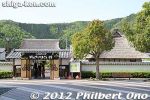
Within Oichi-no-Sato is the Azai Folk History Museum, a small complex of history museums.
|
|
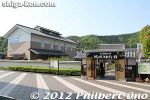
Walk past the library and you come to the gate of the Azai Folk History Museum. Admission 300 yen. Open 9 am to 5 pm, closed Mon. (open if a national holiday) and the day after a national holiday.
|
|
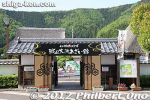
Entrance to Azai Folk History Museum.
|
|

Azai Folk History Museum has a few buildings around an iris pond.
|
|

About the Battle of Anegawa.
|
|
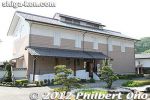
On the left is this modern structure called the Folk Studies Museum or Kyodo Gakushu-kan. It centers on the history of Odani Castle and three generations of the Azai Clan. 郷土学習館
|
|
|
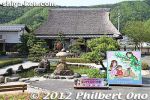
In the rear is the thatch-roofed Shichirinkan 七りん館
|
|

The Azai Folk History Museum (Azai Rekishi Minzoku Shiryokan) has two large thatched-roof houses. This one is called Itohime no Yakata which shows Azai's silk production history. 糸姫の館 MAP
|
|
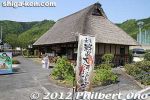
Itohime no Yakata
|
|
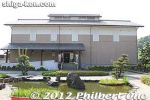
Folk Studies Museum or Kyodo Gakushu-kan. It centers on the history of Odani Castle and three generations of the Azai Clan. 郷土学習館
|
|
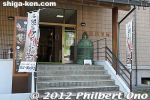
Entrance to Folk Studies Museum.
|
|
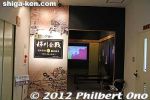
Video room explaining the Battle of Anegawa River.
|
|

Video screening room explaining the Battle of Anegawa River.
|
|
|
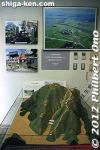
Model of Odani Castle on Mt. Odani.
|
|
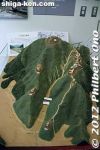
Model of Odani Castle.
|
|

Exhibits about the Battle of Anegawa River.
|
|
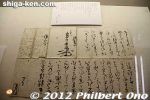
Order written by Toyotomi Hideyoshi to award any Shizugatake residents a reward for killing his enemy.
|
|
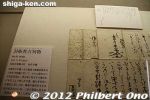
Letter from Ishida Mitsunari.
|
|
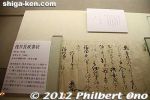
Thank you letter from Azai Nagamasa to a temple for their cooperation in civil construction work.
|
|
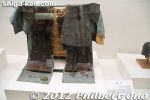
Armor worn around the belly by low-ranking samurai to protect against spears and swords. Supposedly used in the Battle of Anegawa.
|
|
|
|
|
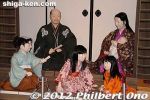
Azai Nagamasa, wife Oichi, son Manpukumaru (left), Chacha in the middle, Hatsu on the right, and Go in Oichi's arms.
|
|
|

Depiction of Oichi and her daughters being allowed to escape Odani Castle while it was under attack by Oda Nobunaga in 1573.
|
|
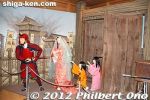
Depiction of Oichi and her three daughters being allowed to escape Odani Castle while it was under attack by Oda Nobunaga in 1573.
|
|
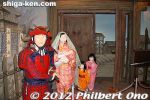
Oichi and daughter Chacha, Hatsu, and Go were led to safety by Fujikake Nagakatsu, a retainer of Oda Nobunaga. He took them to Gifu Castle.
|
|
|
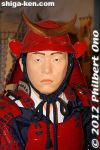
A few years before the attack, Fujikake Nagakatsu, a retainer of Oda Nobunaga, had been assigned to Odani Castle to look after Nobunaga's sister Oichi. 藤懸永勝
|
|
|

About the castle gate.
|
|

Right after their escape from Odani Castle, Oichi and her three daughters went to a nearby temple in Nagahama whose priest was Nagamasa's older sister. The priest hid the three girls in her robes when Nobunaga's men arrived.It is not known for sure where Oichi and the Azai sisters escaped to. This is only one supposition.
|
|
|
|
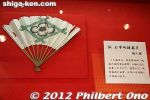
Folding fan supposedly used by Oichi.
|
|
|

This folding panel greets you with a portrait of Lord Azai Nagamasa and wife Ichi.
|
|

Model of Odani Castle on a mountaintop.
|
|

More exhibits about local history.
|
|

Portrait panels of Nagamasa, Ichi, and their three daughters.
|
|

Ichi or Oichi, wife of Azai Nagamasa.
|
|

Lord Azai Nagamasa
|
|

Map of the Battle of Anegawa where Lord Azai Nagamasa fought against Tokugawa Ieyasu and Oda Nobunaga in 1570.
|
|

Second floor of the museum with a fake stone castle gate.
|
|
|

Relics from Odani Castle
|
|

Fan said to have belonged to Ichi.
|
|

Blacksmith-related materials.
|
|

Photo of an unusual ax.
|
|

Inside Shichirinkan, a former blacksmith's house from the 19th century. 七りん館
|
|

When I visited in Feb. 2009, there was an exhibit showing artifacts of a local Okonai Festival (held in various locations during Jan. to March to pray for a good harvest).
|
|

Feast for Okonai Festival.
|
|

Food for Okonai Festival.
|
|
|
|
|
|

Kitchen.
|
|
|
|
|

Wooden bathtub
|
|

How they bathed in the bathtub.
|
|

Near the entrance was the wooden bath.
|
|
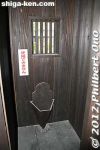
Urinal
|
|
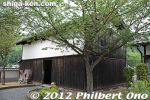
Blacksmith's shop
|
|
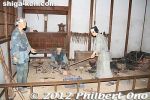
Inside Blacksmith's shop.
|
|
|
|
|
|

This is Itohime no Yakata which shows Azai's silk production history. 糸姫の館
|
|
|
|
|
|
|
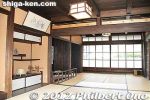
Inside Itohime no Yakata.
|
|

Large exhibition rooms.
|
|

Products which use silk threads made in Azai. They were mainly used for the strings of string instruments such as the koto, samisen, and biwa lute.
|
|

Koto strings made of Azai silk threads. Numerous silk threads are twisted together to make a koto string.
|
|

Biwa strings
|
|

Biwa lute
|
|

Silk cocoons.
|
|

Room with a hearth.
|
|
|
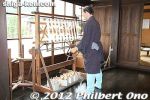
Silk threads.
|
|
|
|
|
|
|

Weaver
|
|
|

Model of silkworm racks.
|
|
|
|

A mannequin spinning silk thread.
|
|
|
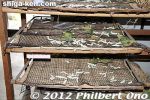
Model of silkworm racks.
|
|
|
|
|
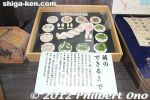
Silk thread
|
|
|
|
|
|
|

Iris pond
|
|
|
|

Path to Tokugen-in Temple. The temple bell indicates that there was a temple here. Tokugen-in had a number of subordinate temples here. They have all gone.
|
|

Cherry tree path to Tokugen-in Temple.
|
|
|
|
|

Temple wall
|
|
|
|
|
|

Stone marker
|
|

Entrance to Kiyotaki Tokugen-in temple.
|
|

Kiyotaki Tokugen-in temple's three-story pagoda in Maibara, Shiga.
|
|

Three-story pagoda
|
|
|

Kiyotaki Tokugen-in temple's three-story pagoda
|
|

Kiyotaki Tokugen-in temple's three-story pagoda
|
|

Kiyotaki Tokugen-in temple's three-story pagoda.
|
|
|
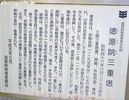
About Kiyotaki Tokugen-in temple's three-story pagoda.
|
|

About the Kyogoku Clan graves at Tokugen-in temple. It was Kyogoku Takatoyo, lord of Marugame in Shikoku, who in 1672 acquired the temple land and gathered all the Kyogoku graves scattered in the area to Tokugen-in.
|
|

Kyogoku Clan graves at Tokugen-in temple. Kyogoku Takatoyo, the 22nd Kyogoku Clan leader, renamed the temple Tokugen-in after the posthumous Buddhist name of his father Takakazu.
|
|

Layout of Kyogoku Clan graves at Tokugen-in temple. There is a lower level and an upper level of graves on a slope accessible by stairs. Although Ujinobu was the first to make it the clan's family temple, it was quite dilapidated by Takatoyo's t
|
|

Entrance to Kyogoku graves. 京極
|
|

Kyogoku clan graves. Grave of Kyogoku Takatsugi is on the left.
|
|

Grave of Kyogoku Takatsugi, husband of Hatsu, one of the Azai sisters.
|
|
|
|
|

Graves of the Tadotsu Clan (多度津藩), a branch of the Kyogoku who ruled in Marugame. From left to right, Kyogoku Takateru (高琢), Takakata (高賢), Takabumi (高文), Takayoshi (高慶), and Takamichi (高通).
|
|
|

Kyogoku clan graves
|
|

The first Kyogoku grave, that of Ujinobu, the founder of the Kyogoku Clan.
|
|

The first Kyogoku grave, that of Ujinobu, the founder of the Kyogoku Clan.
|
|
|

View from the upper level Kyogoku graves.
|
|
|

Graves of the Tadotsu Clan (多度津藩), a branch of the Kyogoku who ruled in Marugame. From left to right, Kyogoku Takateru (高琢), Takakata (高賢), Takabumi (高文), Takayoshi (高慶), and Takamichi (高通). National Historic Site
|
|
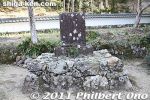
Epitaph 碑文
|
|
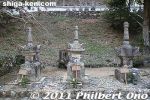
Graves of Kyogoku Takayoshi (京極 高美), Takatoo (京極 高迢), and Takamasa (京極高政). They were much less prominent.
|
|
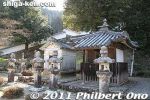
Kyogoku Takatsugi and Kyogoku Takanori's (1718-1763) grave
|
|
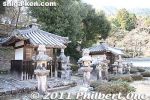
Kyogoku Takanori (1718-1763) and Kyogoku Takanaka's (1754-1811) graves.
|
|
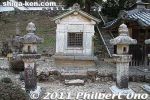
Kyogoku Takatsugu's grave.
|
|
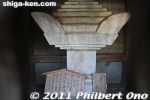
Inside Kyogoku Takatsugu's grave.
|
|
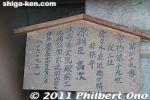
Kyogoku Takatsugu's grave.
|
|
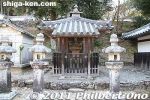
Kyogoku Takanori's (1718-1763) grave. He was the fourth lord of Marugame in Shikoku. 京極高矩
|
|
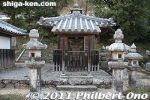
Kyogoku Takanaka's (1754-1811) grave. He was the fifth lord of Marugame in Shikoku. 京極高中
|
|
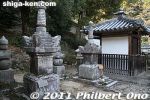
Two lesser graves for Kyogoku Tadataka (京極忠高) and Takakazu (京極高和), the eldest son of Takatsugu.
|
|
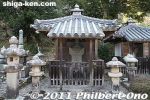
Grave of Kyogoku Takatoyo, second lord of Marugame in Shikoku. 京極高豊
|
|
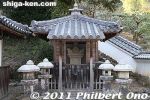
Grave of Kyogoku Takamochi, third lord of Marugame in Shikoku. 京極高或
|
|
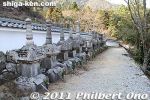
There are steps to go up the hill where there are more Kyogoku graves. These are for the older Kyogoku members, starting with the founder of the Kyogoku Clan.
|
|
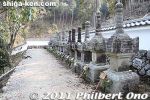
The narrow upper level has 18 gravestones, starting with the first Kyogoku Clan leader Ujinobu on the right.
|
|
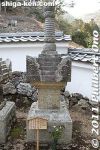
The first Kyogoku grave, that of Ujinobu, the founder of the Kyogoku Clan. 氏信
|
|
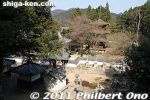
View from the hill.
|
|

More autumn foliage outside the back corner of Tokugen-in.
|
|
|
|
|
|

Red maple leaves
|
|
|

Famous cherry tree (in fall)
|
|

Path to Kannon statues on a slope next to the temple.
|
|
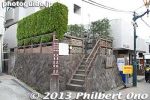
Gravesite of the Hojo Clan.
|
|

About the Gravesite of the Hojo Clan.
|
|
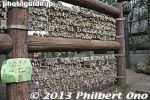
Good luck bells greet you at the gravesite.
|
|

About the good luck bells.
|
|
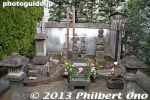
Hojo clan gravesite in Odawara. At the center are two small grave stones. The left one is for Hojo Ujiteru, and the right one is Hojo Ujimasa (they are brothers). The large gravestone on the right is for Ujimasa's wife.
|
|

Identification of the Hojo Clan graves.
|
|
|
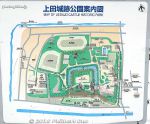
Ueda Castle is in a nice park with Sanada Shrine. The Honmaru is the main part where there are reconstructed structures.The castle is a short bus/taxi ride from JR Ueda Station.
|
|
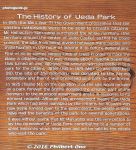
About the history of the castle park.
|
|

Sign promoting an exhibition at Ueda Castle in tandem with the NHK Taiga drama "Sanada Maru" in 2016.
|
|

In front of the main gate of Ueda Castle. We visited in Jan. 2016 after heavy snow fell.
|
|

Ueda Castle was the base of the Sanada Clan who defended the castle against the Tokugawa in 1585 and 1600. The battle here prevented Tokugawa Hidetada from joining Ieyasu at Sekigahara in 1600.
|
|

Main gate of Ueda Castle.
|
|
|

A publicity team dressed in period costume greets visitors to Ueda Castle.
|
|

Dressed as Sanada at Ueda Castle, Nagano Prefecture.
|
|

Ueda Castle inner moat around the Honmaru.
|
|

South Turret of Ueda Castle.
|
|
|

Main gate of Ueda Castle and North Turret.
|
|

Main gate of Ueda Castle.
|
|

North Turret of Ueda Castle.
|
|
|
|
|

Giant Sanada Stone.
|
|

About the Sanada Stone.
|
|

Back side of main gate.
|
|

Back side of main gate and South Turret.
|
|

Reconstructed South Turret of Ueda Castle is open to the public.
|
|

Inside the South Turret of Ueda Castle.
|
|
|
|
|
|

Snowy view from the South Turret.
|
|

West Turret as seen from the South Turret.
|
|

View from the South Turret.
|
|

East Turret over the East (main) Gate.
|
|

East Turret over the East (main) Gate.
|
|
|

Inside the East Turret over the East (main) Gate.
|
|
|
|

View from the East Turret over the East (main) Gate. Where we entered the castle grounds.
|
|

East Turret over the East (main) Gate.
|
|

North Turret of Ueda Castle.
|
|

North Turret of Ueda Castle.
|
|

North Turret of Ueda Castle.
|
|
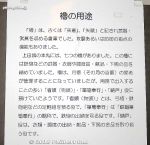
The turrets were used to store spears and other weapons.
|
|

Ueda banners
|
|

Inside the North Turret.
|
|

Inside the North Turret.
|
|
|
|
|
|
|

View from the North Turret overlooking the moat.
|
|

Sanada Shrine torii.
|
|

Path to Sanada Shrine, a rather small shrine.
|
|

Samurai helmet monument
|
|

Sanada Shrine worship hall.
|
|
|

Sanada Shrine
|
|

Inside Sanada Shrine
|
|
|
|